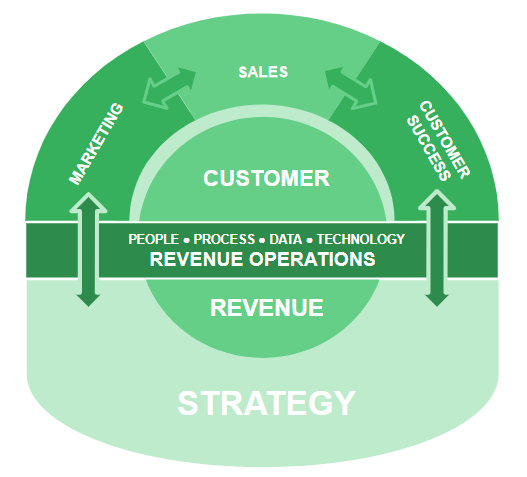Impacting the Bottom Line: The Four Pillars of RevOps

In the last post, we introduced the concept of Revenue Operations (RevOps) and reviewed seven RevOps objectives in the context of Digital Transformation. In this article, we will explore WHY RevOps should matter to your organization, and what to consider when you decide to integrate RevOps principles in your organization.
Previously, we defined RevOps as a strategic approach that involves aligning and optimizing all revenue-generating functions within an organization. To build on this definition, we will categorize revenue-generating functions based on the revenue life cycle capabilities:
– Lead Generation
– Sales Productivity and Lead Conversion
– Revenue Recognition and Billing
– Customer Success and Retention
Each of these capabilities is essential in the revenue life cycle but when aligned and optimized through RevOps, it can have immense impact on the success of the organization. For example, TGG recently partnered with a client to optimize their sales function to best serve the organization. After an in-depth opportunity analysis, we connected the findings to their customer segmentation analysis, growth targets and seller performance, creating sophisticated models providing leadership with organizational design options and their impact on headcount and account coverage.
– Lead Generation: RevOps ensures that marketing and sales efforts are closely aligned, resulting in higher-quality leads and improved conversion rates. It streamlines processes for lead nurturing and qualification, enabling the efficient allocation of resources to the most promising opportunities.
– Sales Productivity and Lead Conversion: Optimizing sales processes, providing sales teams with the right tools, and offering data-driven insights, RevOps empowers sales professionals to work more efficiently and provides focus for their efforts on closing deals that are more likely to convert. It enables real-time visibility into the sales pipeline, allowing for proactive problem-solving and timely interventions to move deals forward. This, in turn, leads to shorter sales cycles and improved win rates.
– Revenue Recognition: The process of formally accounting for the revenue earned and it involves adhering to accounting standards and practices to accurately record and report revenue. Billing and payment processing are also crucial, ensuring that customers receive timely invoices and make payments.
– Customer Success: RevOps principles ensure that customer data is not lost after the sale but is actively used to drive post-sale engagement and satisfaction. This fosters long-term relationships, encourages upselling and cross-selling opportunities, and ultimately contributes to higher customer lifetime value.

Connecting and streamlining the main capabilities of the revenue life cycle through RevOps, provides a centralized and essential business motor to drive strategic value. By unifying sales, marketing, and customer success functions, RevOps ensures a holistic, data-driven approach to revenue management. This alignment enhances decision-making, maximizes operational efficiency, and provides a deeper understanding of customer behavior. RevOps empowers organizations to adapt quickly to market changes, identify growth opportunities, and scale effectively. In essence, it transforms revenue generation from a siloed, reactive effort into a strategic and proactive engine that propels business growth and success, making it a backbone function for any forward-thinking company.
Now that we understand the WHY behind RevOps, let’s explore the HOW – that is – how to deploy RevOps. As with every transformation, it involves four key pillars: people, process, data, and technology. Let’s delve into each aspect to understand how to successfully roll out this essential function.
PEOPLE
Building a capable RevOps team is the first and crucial step. RevOps professionals need to possess a unique blend of skills, including sales, marketing, finance, and data analytics. Start by clearly defining roles and responsibilities, then invest in training and make sure to keep your RevOps team updated on industry trends and tools. The most critical activity is to encourage collaboration between marketing, sales and customer success teams to ensure alignment and understanding of a shared vision.
PROCESS
Streamlining revenue-related processes is the cornerstone of RevOps. Start by mapping out your customer journey and end-to-end revenue process that support the customer journey, from lead generation to customer retention. Identify gaps, bottlenecks and inefficiencies in the existing processes. Develop a roadmap to address or preferably eliminate them. Develop and implement sales enablement strategies to equip your sales team with the right resources, content, and tools.
DATA
Harness the power of data – it is the core of well functioning RevOps. Start with ensuring that your customer data is centralized, consistent and accessible. Implement robust analytics and reporting tools to gain insights into sales performance, customer behaviors and revenue life cycle. Above all, value customer trust by prioritizing data security and assuring compliance with relevant regulations. To learn more how to assess your organization’s data maturity, click HERE.
TECHNOLOGY
Markets are saturated with numerous tools that claim to be the be-all and end-all of any given application type, so pick your tools wisely and be very selective. Identify technology gaps in the processes and look for tools that can not only fill those gaps but also add efficiency. Work with your technology team to ensure that the selected tool can be seamlessly integrated into your organizational ecosystem. You want to avoid creating data and/or process silos by adding new applications. Regularly assess the performance of your technology stack and make adjustments as needed to assure technology is efficiently supporting your people, processes and data.
As you strategize putting RevOps into action, remember that it’s not a brief project; instead, it’s a meticulously orchestrated transformation that requires deliberate change management practices and adept communication. We will explore this topic more later in this series.
In summary, the Revenue Operations function involves more than just adopting new tools; it’s a holistic approach that requires attention to people, processes, data, and technology. By assembling the right team, streamlining processes, harnessing data, and investing in the right technology, your organization can position itself for sustainable revenue growth and operational excellence. Embrace the RevOps approach, and you’ll be better equipped to adapt to the ever-evolving business landscape and drive success in the long run.
At this point, we shared with you WHERE RevOps fits in the context of Digital Transformation, WHAT RevOps is, WHY it should be important to your organization and HOW to implement it. As we continue with this series, next, we will explore different metrics that will help you organize for success, optimize performance, and maximize revenue.
